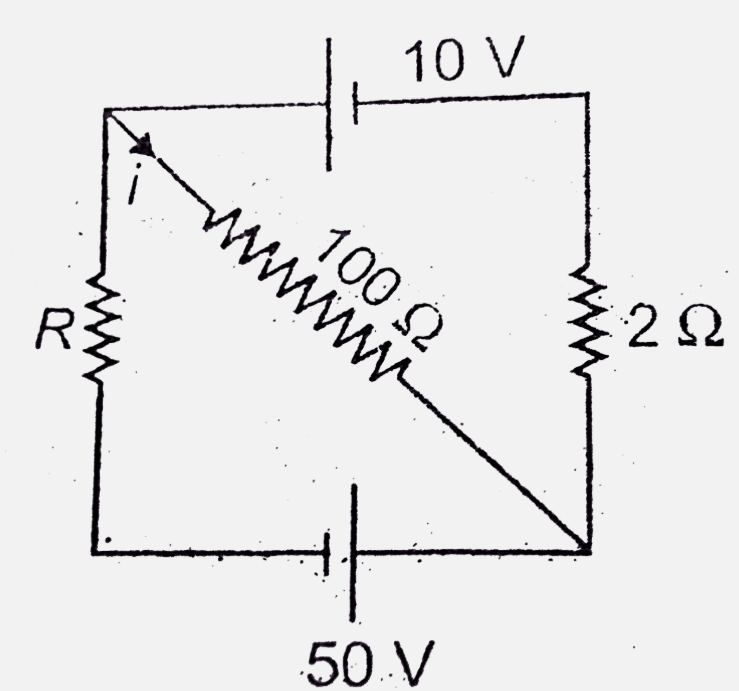In an AC circuit , it if found that the current is zero when voltage is at its maximum. Which components may be present in the circuit ?
To solve the problem, we need to analyze the relationship between current and voltage in an AC circuit, particularly when the current is zero while the voltage is at its maximum.
1. Understanding AC Circuit Behavior: In an alternating current (AC) circuit, both current and voltage vary sinusoidally with time. The voltage can be expressed as V(t)=Vmsin(ωt), where Vm is the maximum voltage and ω is the angular frequency.
2. Identifying Phase Relationship: The current in an AC circuit can also be expressed in a similar form: I(t)=Imsin(ωt+ϕ), where Im is the maximum current and ϕ is the phase difference between the current and voltage.
3. Condition Given in the Problem: The problem states that the current is zero when the voltage is at its maximum. Mathematically, this means:
- Voltage is maximum when sin(ωt)=1 (i.e., ωt=π2+2nπ for integer n).
- Current is zero when sin(ωt+ϕ)=0.
4. Finding the Phase Difference: For the current to be zero when the voltage is at its maximum, we need:
ωt+ϕ=nπ(n is an integer)
Substituting ωt=π2+2nπ into the equation gives:
π2+2nπ+ϕ=nπ
Rearranging this leads to:
ϕ=nπ−π2−2nπ=−π2+(n−2n)π
This indicates that ϕ=−π2 or ϕ=3π2, which corresponds to a phase difference of 90∘ or −90∘.
5. Identifying Circuit Components: A phase difference of 90∘ occurs in a circuit that contains:
- An inductor (L) or a capacitor (C) but not both in a way that would introduce resistance.
- If there is no resistance (R = 0), the circuit behaves as a purely inductive or purely capacitive circuit.
6. Conclusion: Therefore, the components that may be present in the circuit are:
- An inductor (L) or a capacitor (C), with the condition that there is no resistance (R = 0).
Final Answer:
The components that may be present in the circuit are an inductor (L) or a capacitor (C), with no resistance (R = 0).
---
- Voltage is maximum when sin(ωt)=1 (i.e., ωt=π2+2nπ for integer n).
- Current is zero when sin(ωt+ϕ)=0.
ωt+ϕ=nπ(n is an integer)
Substituting ωt=π2+2nπ into the equation gives:
π2+2nπ+ϕ=nπ
Rearranging this leads to:
ϕ=nπ−π2−2nπ=−π2+(n−2n)π
This indicates that ϕ=−π2 or ϕ=3π2, which corresponds to a phase difference of 90∘ or −90∘.
- An inductor (L) or a capacitor (C) but not both in a way that would introduce resistance.
- If there is no resistance (R = 0), the circuit behaves as a purely inductive or purely capacitive circuit.
- An inductor (L) or a capacitor (C), with the condition that there is no resistance (R = 0).
The components that may be present in the circuit are an inductor (L) or a capacitor (C), with no resistance (R = 0).
Topper's Solved these Questions
- ALTERNATING CURRENT Book:MODERN PUBLICATIONChapter:ALTERNATING CURRENT Exercise:TOUGH & TRICKY PROBLEMS
Explore 12 Videos
- ALTERNATING CURRENT Book:MODERN PUBLICATIONChapter:ALTERNATING CURRENT Exercise:NCERT FILE (TEXTBOOK EXERCISES )
Explore 11 Videos
- ALTERNATING CURRENT Book:MODERN PUBLICATIONChapter:ALTERNATING CURRENT Exercise:PRACTICE PROBLEMS
Explore 67 Videos
- ATOMS Book:MODERN PUBLICATIONChapter:ATOMS Exercise:Chapter Practice Test
Explore 16 Videos
Similar Questions
Knowledge Check
In an A.C. circuit the current
AAlways leads the voltageBAlways lags behind the voltageCIs always in phase with the voltageDMay lead or lag behind or be in phase with the voltageIn an ac circuit the current
Ais in phase with the voltageBleads the voltageClags the voltageDany of the above depending on the circumstancesIn an AC circuit with voltage V and current I, the power dissipated is
AVIB12VIC1√2VIDDepened on the phase between V and I
In an AC series circuit, the instanctaneous current is zero when the instantaneous voltage is xamimum. Connected to the source may be a
View SolutionIn an ac circuit, the current lags behind the voltage by π/3. The components in the circuit are
View SolutionIn an a.c. circuit with voltage V and current I, the power dissipated is
View SolutionIn an LCR series ac circuit, the current is
View SolutionIn an a.c. series circuit, the instantaneous current is maximum when the instantaneous voltage is maximum. The circuit element connected to the source will be
View Solution


